Posted under New Zealand
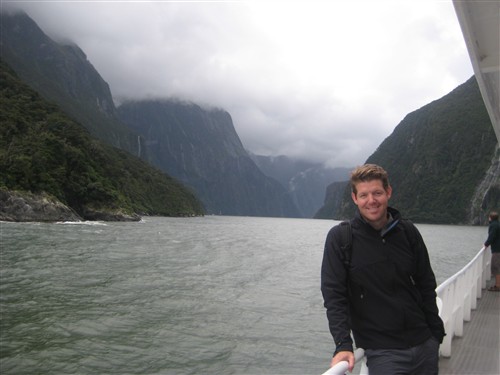 Fiordland National Park is inclusive of 3 million acres in the southwest region of the South Island. This region is covered in dense, mountainous rainforest and meets the Tasman Sea on its western coast. The fiords were created during the ice ages when glaciers repeatedly advanced and regressed, cutting narrow and steep-sided valleys through the rock, which then became flooded by the sea. The national park is one of the wettest places in the world with some areas collecting almost 7 meters of rainfall per year. Not surprisingly, it was raining as we drove into the park on a day trip from Queenstown. The 4.5 hour drive was a series of picture-perfect landscapes and as we neared the fiordlands, we began to see the rainwater cascading down the sheer granite rock faces of the surrounding mountains.
Fiordland National Park is inclusive of 3 million acres in the southwest region of the South Island. This region is covered in dense, mountainous rainforest and meets the Tasman Sea on its western coast. The fiords were created during the ice ages when glaciers repeatedly advanced and regressed, cutting narrow and steep-sided valleys through the rock, which then became flooded by the sea. The national park is one of the wettest places in the world with some areas collecting almost 7 meters of rainfall per year. Not surprisingly, it was raining as we drove into the park on a day trip from Queenstown. The 4.5 hour drive was a series of picture-perfect landscapes and as we neared the fiordlands, we began to see the rainwater cascading down the sheer granite rock faces of the surrounding mountains.
The ecosystem within the fiordlands is fascinating. All of the plant species in this region require large quantities of water; without the exceptional levels of rainfall in the fiordlands, none of the plants could survive. A true rainforest, the plants and trees grow directly on the rock. Without soil, the plants must survive on water and sunlight. The process begins with mosses and ferns growing on the rock face, creating a firm base for trees to root and grow. The trees mature and intertwine, creating a canopy over the moss and ferns and shielding them from the harsh rains and most intense sunlight. This allows them to flourish into lush, thick undergrowth. This system of interdependence allows the plants and trees to grow heartily on an almost vertical rock face. With no soil on the mountains to soak up the rain, the water streams down the mountain in hundreds of white ribbons.
We arrived at Milford Sound, invigorated by the phenomenal beauty in our midst, and walked to the cruise office to try to get onto a cruise around the sound. Luckily, there was space on a boat that was leaving in ten minutes and we hurried down the dock to board. There are many more luxurious ways to see Milford Sound, involving Cessna flights, helicopters and plush overnight cruises but the price curve is painfully steep for budget travelers. Our little cruise vessel provided a basic level of comfort despite the rain, and a lovely trip around the sound.
In contrast to a fiord, a sound is “a river valley flooded by the sea following a rise in sea levels or depression of the land”. Milford Sound is protected from the waves of the Tasman Sea by tall, steep mountains so its waters are as tranquil as a lake. Our ship cruised slowly, skirting the steep slopes that plunge dramatically into the sound, granting views of stunning rock formations, lush rainforest, and streams of whitewater negotiating granite contours and a small colony of New Zealand Fur Seals. A steady drizzle and cloudy, gray skies diminished the postcard-perfection of our photographs but we both agreed that photos simply don’t capture the humbling majesty on this natural wonder. Staring in awe at the stark vertical rock faces, you can imagine a fast-forwarded version of the erosion that cut the land into a brilliant masterpiece over millions of years. You can envision the creation and progression of the rainforest, growing and fortifying itself, layer by layer, and yet marvel at its fragility – its dependence on the heavy rainfall, specific to this region, and to every other organism in the ecosystem. You can breathe in the fresh, moist air on a fiordland trail under a canopy of green.
 On our way out of the national park, we stopped briefly for a nature walk on one of the shorter trails, called The Chasm. The rain and long drive ahead precluded us from endeavoring to hike further in but we wanted a glimpse of the trails. The path cut through dense green forest, curving around granite boulders and crossing over rocky, meandering streams. There were tiny, hidden waterfalls, abundant ferns and mosses in red, green and gold. Water trickled down moss-covered rocks, dripping from the glistening pointed tips of ferns. Everything looked so alive! During a twenty-minute hike, we crossed at least three bodies of water – all feats of sublime natural artistry; strewn with contoured boulders and fallen trees. The canopy of entwined trees overhead sheltered us from the rain and we could have walked longer were it not for two compelling forces: the narrow, tortuous road beckoning us to begin the long journey home and the hot meal and bottle of wine at the end of the road.
On our way out of the national park, we stopped briefly for a nature walk on one of the shorter trails, called The Chasm. The rain and long drive ahead precluded us from endeavoring to hike further in but we wanted a glimpse of the trails. The path cut through dense green forest, curving around granite boulders and crossing over rocky, meandering streams. There were tiny, hidden waterfalls, abundant ferns and mosses in red, green and gold. Water trickled down moss-covered rocks, dripping from the glistening pointed tips of ferns. Everything looked so alive! During a twenty-minute hike, we crossed at least three bodies of water – all feats of sublime natural artistry; strewn with contoured boulders and fallen trees. The canopy of entwined trees overhead sheltered us from the rain and we could have walked longer were it not for two compelling forces: the narrow, tortuous road beckoning us to begin the long journey home and the hot meal and bottle of wine at the end of the road.
 We checked into Scallywag’s Travelers Guesthouse and were awestruck by the million-dollar view of the lake and surrounding mountains from our bedroom window. We drove into town to pick up some groceries for the next few days – after two months of eating every meal out in India and Thailand, we’re back to self-catering – and then stopped at the charming Vudu Café in town for an appetizer, a couple of microbrews and some great people-watching. From our perch at a sidewalk table, we hypothesized that the tourist population in Queenstown was comprised of the following groups in almost equal parts: Australians and North Island Kiwis on holiday, Japanese tourists, Europeans (spending their soaring Euros and towering Pounds) and Americans (spending their sadly deflating dollars) on family vacations, and thrifty globetrotters (most of whom fall into the European category) like ourselves, monopolizing every camper van and backpacker hostel available for miles. Back at Scallywag’s, we finished the evening with some local wine and cheese and good conversation around the dinner table with some other interesting couples at the hostel.
We checked into Scallywag’s Travelers Guesthouse and were awestruck by the million-dollar view of the lake and surrounding mountains from our bedroom window. We drove into town to pick up some groceries for the next few days – after two months of eating every meal out in India and Thailand, we’re back to self-catering – and then stopped at the charming Vudu Café in town for an appetizer, a couple of microbrews and some great people-watching. From our perch at a sidewalk table, we hypothesized that the tourist population in Queenstown was comprised of the following groups in almost equal parts: Australians and North Island Kiwis on holiday, Japanese tourists, Europeans (spending their soaring Euros and towering Pounds) and Americans (spending their sadly deflating dollars) on family vacations, and thrifty globetrotters (most of whom fall into the European category) like ourselves, monopolizing every camper van and backpacker hostel available for miles. Back at Scallywag’s, we finished the evening with some local wine and cheese and good conversation around the dinner table with some other interesting couples at the hostel.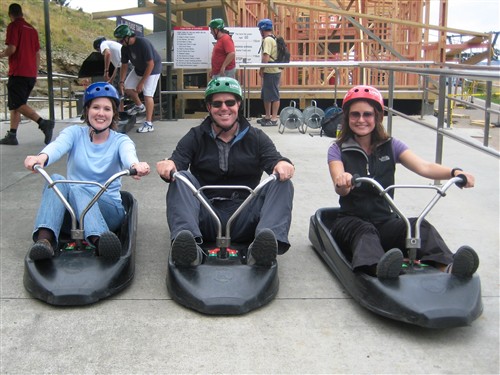 Needless to say, this activity was Aaron’s pick and he was, inarguably, the most antagonistic and enthusiastic racer. We moved onto the advanced track after our introductory run and Aaron tried to coax us into racing each other on the next five runs. I think the spirit of friendly competition overcame him as he took turns on two wheels, sticking his leg out the side to keep from flipping sideways, and flew over long drops with one hand in the air. On one run, he was so intent on keeping me in his sights as I threatened to pass him that he almost crashed into the side of the tunnel wall. He was like a teenager breaking all of the track safety rules and I was the scolding mother hen, flashing forward to the gruesome scene of having my thirty-year-old husband air-lifted from the mountain to the nearest hospital to set broken bones from flying off the luge track. Incorrigible! But it was fun to witness such youthful exuberance. Adulthood and its corresponding worries and responsibilities seem to suffocate the frolicsome, free-spirited nature of many people but I have a sneaking suspicion that it won’t happen to us. As I flash back to that cheeky, insolent, mischievous grin in sunglasses and Speed Racer helmet, in fact, I am certain of it.
Needless to say, this activity was Aaron’s pick and he was, inarguably, the most antagonistic and enthusiastic racer. We moved onto the advanced track after our introductory run and Aaron tried to coax us into racing each other on the next five runs. I think the spirit of friendly competition overcame him as he took turns on two wheels, sticking his leg out the side to keep from flipping sideways, and flew over long drops with one hand in the air. On one run, he was so intent on keeping me in his sights as I threatened to pass him that he almost crashed into the side of the tunnel wall. He was like a teenager breaking all of the track safety rules and I was the scolding mother hen, flashing forward to the gruesome scene of having my thirty-year-old husband air-lifted from the mountain to the nearest hospital to set broken bones from flying off the luge track. Incorrigible! But it was fun to witness such youthful exuberance. Adulthood and its corresponding worries and responsibilities seem to suffocate the frolicsome, free-spirited nature of many people but I have a sneaking suspicion that it won’t happen to us. As I flash back to that cheeky, insolent, mischievous grin in sunglasses and Speed Racer helmet, in fact, I am certain of it.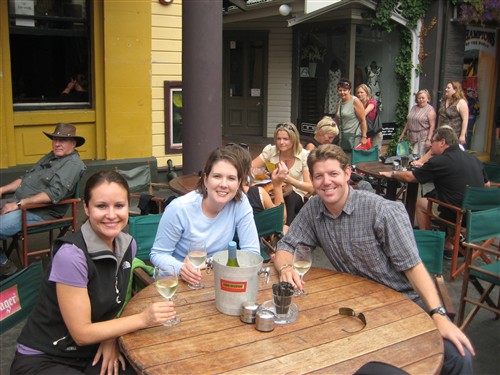 Six action-packed runs down the luge track left the three of us weary and ready for a grown-up’s beverage. We hopped back onto the gondola for the picturesque descent and then walked into town. Queenstown has so many tempting venues for afternoon (après adrenaline rush) cocktails and we didn’t walk long before settling into a patio table with a bottle of Oyster Bay Sauvignon Blanc from the Marlborough region in the north. The Central Otago wine region, just outside of Queenstown, is known for its Pinot Noirs; however, I would argue that there is scarcely a better wine to have on a sunny afternoon than a well-chilled Marlborough Sauvignon Blanc. Interestingly, it is more expensive to drink NZ wines in NZ than in the States.
Six action-packed runs down the luge track left the three of us weary and ready for a grown-up’s beverage. We hopped back onto the gondola for the picturesque descent and then walked into town. Queenstown has so many tempting venues for afternoon (après adrenaline rush) cocktails and we didn’t walk long before settling into a patio table with a bottle of Oyster Bay Sauvignon Blanc from the Marlborough region in the north. The Central Otago wine region, just outside of Queenstown, is known for its Pinot Noirs; however, I would argue that there is scarcely a better wine to have on a sunny afternoon than a well-chilled Marlborough Sauvignon Blanc. Interestingly, it is more expensive to drink NZ wines in NZ than in the States. G’day! Welcome to New Zealand! Population: 4 million humans; 40 million sheep. The locals are called Kiwis, gentlemen are blokes, friends are mates, and vowels are consistently butchered in the endearing Kiwi-accented English. The most common fast food is fish and chips or “fush ‘n’ chups” and, not surprisingly, lamb is a staple entrée on Kiwi dinner tables. New Zealand’s two islands, the North and South Islands, are together about the size of Colorado and rival its stunning alpine landscapes. The Lord of the Rings films were shot against New Zealand’s fairytale backdrops. The remote islands attract almost 3 million foreign tourists each year who are drawn to the postcard-perfect views, outdoor activities, beaches, lakes, mountains, wineries and lack of terrorism. The weather in NZ is gorgeous right now – sunny, breezy and 70s during the days and cool enough for a light jacket in the evenings. The sun doesn’t set until sometime between eight and nine o’clock so each day is long and full of possibility.
G’day! Welcome to New Zealand! Population: 4 million humans; 40 million sheep. The locals are called Kiwis, gentlemen are blokes, friends are mates, and vowels are consistently butchered in the endearing Kiwi-accented English. The most common fast food is fish and chips or “fush ‘n’ chups” and, not surprisingly, lamb is a staple entrée on Kiwi dinner tables. New Zealand’s two islands, the North and South Islands, are together about the size of Colorado and rival its stunning alpine landscapes. The Lord of the Rings films were shot against New Zealand’s fairytale backdrops. The remote islands attract almost 3 million foreign tourists each year who are drawn to the postcard-perfect views, outdoor activities, beaches, lakes, mountains, wineries and lack of terrorism. The weather in NZ is gorgeous right now – sunny, breezy and 70s during the days and cool enough for a light jacket in the evenings. The sun doesn’t set until sometime between eight and nine o’clock so each day is long and full of possibility.
 As we leisurely strolled by the lines of lobster tails, gargantuan prawns and all varieties of fresh fish, the candlelit tables with well-dressed two-week travelers toasting glistening glasses of vino, we were almost immune to the decadence in which our former yuppie selves would once have thoughtlessly indulged with the easy swipe of a credit card. No, after four straight days of Thai cuisine on the dive boat, we had tunnel vision and, at the end of the tunnel, was Ronald McDonald saying “Sawasdee Khrap” with traditional Thai prayer hands. In the States, our fast food cravings were few and far between but, on the road, those golden arches symbolize a little taste of home. So often while traveling, we order a dish that is considered “international” to that particular country and it never meets our wishful expectations. For example, I ordered spicy Chinese chow mein noodles in India and got spaghetti noodles swimming in Tabasco. Aaron ordered a grilled cheese in Thailand and got two slices of cold toast with lettuce, tomato and a non-melted slice of white processed cheese. An Italian restaurant in India isn’t owned by an Italian expatriate but rather an ambitious Indian whose interpretation of Italian food would surely induce a spew of curses from any true blood Italian. At McDonald’s, you know that the double cheeseburger and fries tastes exactly the same in Thailand as it does at home. With our bellies full of greasy fast food, we rolled ourselves back to the hotel to relax and hibernate after our long day.
As we leisurely strolled by the lines of lobster tails, gargantuan prawns and all varieties of fresh fish, the candlelit tables with well-dressed two-week travelers toasting glistening glasses of vino, we were almost immune to the decadence in which our former yuppie selves would once have thoughtlessly indulged with the easy swipe of a credit card. No, after four straight days of Thai cuisine on the dive boat, we had tunnel vision and, at the end of the tunnel, was Ronald McDonald saying “Sawasdee Khrap” with traditional Thai prayer hands. In the States, our fast food cravings were few and far between but, on the road, those golden arches symbolize a little taste of home. So often while traveling, we order a dish that is considered “international” to that particular country and it never meets our wishful expectations. For example, I ordered spicy Chinese chow mein noodles in India and got spaghetti noodles swimming in Tabasco. Aaron ordered a grilled cheese in Thailand and got two slices of cold toast with lettuce, tomato and a non-melted slice of white processed cheese. An Italian restaurant in India isn’t owned by an Italian expatriate but rather an ambitious Indian whose interpretation of Italian food would surely induce a spew of curses from any true blood Italian. At McDonald’s, you know that the double cheeseburger and fries tastes exactly the same in Thailand as it does at home. With our bellies full of greasy fast food, we rolled ourselves back to the hotel to relax and hibernate after our long day. Back on the streets of Patong Beach, we learned that Jon would come over from Phuket Town and meet us around 11:30 so we had a couple of hours to kill around town. With our day at the beach finally pushing a wave of fatigue over us, we alternated between beer and iced coffee as we bar hopped and browsed the cute little clothing shops. By day, Patong is a family-friendly atmosphere but the blackening sky brings out the seedier elements – beautiful, young Thai prostitutes accompanying unattractive, middle-aged western men; scantily clad “ladyboys” dancing on bars and posing for raunchy photos with tourists for cash; costumed cabaret dancers beckoning patrons inside and plenty of adult entertainment venues offering menus of perversities. Sex is definitely for sale in Thailand. We met Jon and a few of his friends and had a spectacular night of alcohol-induced people-watching as we bounced around to a few different bars. When we finally made it back to our hotel, around 4 a.m., we passed out and woke the next morning (surprisingly not hung over) with just enough time to quickly shower and check out. It was the perfect end to our adventures in southern Thailand.
Back on the streets of Patong Beach, we learned that Jon would come over from Phuket Town and meet us around 11:30 so we had a couple of hours to kill around town. With our day at the beach finally pushing a wave of fatigue over us, we alternated between beer and iced coffee as we bar hopped and browsed the cute little clothing shops. By day, Patong is a family-friendly atmosphere but the blackening sky brings out the seedier elements – beautiful, young Thai prostitutes accompanying unattractive, middle-aged western men; scantily clad “ladyboys” dancing on bars and posing for raunchy photos with tourists for cash; costumed cabaret dancers beckoning patrons inside and plenty of adult entertainment venues offering menus of perversities. Sex is definitely for sale in Thailand. We met Jon and a few of his friends and had a spectacular night of alcohol-induced people-watching as we bounced around to a few different bars. When we finally made it back to our hotel, around 4 a.m., we passed out and woke the next morning (surprisingly not hung over) with just enough time to quickly shower and check out. It was the perfect end to our adventures in southern Thailand.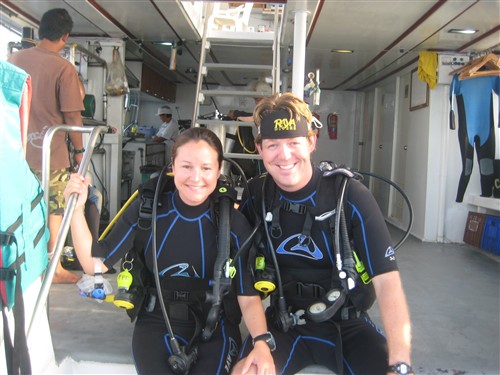 Most scuba divers will tell you that the best diving is done from a live aboard boat. A live aboard is basically a sea-worthy vessel equipped with sleeping berths and a dedicated deck to house scuba tanks, equipment and an air compressor. These boats usually sleep as few as six people or as many as thirty, depending upon the size and design of the boat, although fewer divers usually makes the experience more pleasant. The advantages of a live aboard are basically three-fold; you can reach far away dive sites which are practically undesirable for a day trip, there’s no need to switch tanks and gear between dives because your original tank is simply refilled by the compressor onboard, and minimized boat travel time means more time for diving. But diving from a live aboard can be expensive and you’re stuck, for better or worse, in rough seas or calm, in the middle of the ocean on a boat. Given our passion for diving and proximity to a world-class diving destination, we tossed our budget out the window and booked the best, last-minute boat deal that we could find; a four-day, four-night trip to the Similans aboard the Vilai Samut.
Most scuba divers will tell you that the best diving is done from a live aboard boat. A live aboard is basically a sea-worthy vessel equipped with sleeping berths and a dedicated deck to house scuba tanks, equipment and an air compressor. These boats usually sleep as few as six people or as many as thirty, depending upon the size and design of the boat, although fewer divers usually makes the experience more pleasant. The advantages of a live aboard are basically three-fold; you can reach far away dive sites which are practically undesirable for a day trip, there’s no need to switch tanks and gear between dives because your original tank is simply refilled by the compressor onboard, and minimized boat travel time means more time for diving. But diving from a live aboard can be expensive and you’re stuck, for better or worse, in rough seas or calm, in the middle of the ocean on a boat. Given our passion for diving and proximity to a world-class diving destination, we tossed our budget out the window and booked the best, last-minute boat deal that we could find; a four-day, four-night trip to the Similans aboard the Vilai Samut.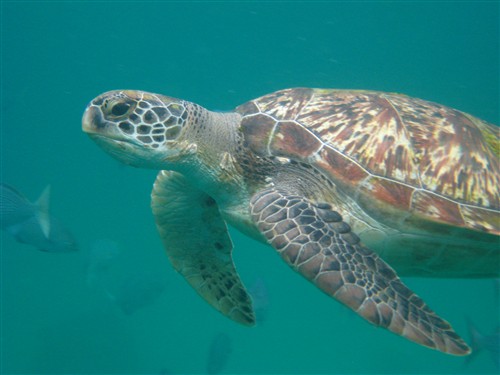 The Vilai Samut (meaning Sea Anchor in Thai), has the capacity to carry 22 divers plus crew, but our trip had only 10 divers plus an all-Thai crew: two dive guides, two kitchen staff, two deckhands, and the captain. Our itinerary included the Similan Islands, plus two small islands north, Koh Tachai and Koh Bon, and an underwater sea mount near the Burma Banks named Richelieu Rock. For three glorious days we followed a full but relaxing daily schedule; 8am dive (one), eat, sleep, 11am dive (two), eat, sleep, 3pm dive (three), eat, sleep, 7pm night dive (four), eat, sleep. We lazed on the sun on deck, immersed ourselves in good books or quiet conversation, and took intermittent naps, lulled by the gentle rocking of the boat.
The Vilai Samut (meaning Sea Anchor in Thai), has the capacity to carry 22 divers plus crew, but our trip had only 10 divers plus an all-Thai crew: two dive guides, two kitchen staff, two deckhands, and the captain. Our itinerary included the Similan Islands, plus two small islands north, Koh Tachai and Koh Bon, and an underwater sea mount near the Burma Banks named Richelieu Rock. For three glorious days we followed a full but relaxing daily schedule; 8am dive (one), eat, sleep, 11am dive (two), eat, sleep, 3pm dive (three), eat, sleep, 7pm night dive (four), eat, sleep. We lazed on the sun on deck, immersed ourselves in good books or quiet conversation, and took intermittent naps, lulled by the gentle rocking of the boat. The diving was good to great, but varied significantly between dive sites. The visibility was better than average but we were often plagued by thermo clines, currents of cold water mixing with warm water, sending chills through our wetsuits and significantly reducing visibility. Most of the reefs were in very good condition, surprisingly unaffected by the December 26, 2004 tsunami that devastated the Thailand west coast. According to our dive guides, the greatest threat to these reefs now is the tourist masses, boating in each day to snorkel and dive the islands. During our twelve dives we found the reefs to be plentiful with fish life, big and small. We saw hundreds of schools of reef fish, numerous giant moray eels, gigantic tuna, a banded sea snake, blue-spotted rays, a great barracuda, a leopard shark, and on our last dive at Koh Bon Island, two majestic, graceful manta rays. During one of our lazy afternoons anchored in an island bay, two green sea turtles graced us with their presence for almost an hour, allowing me to swim with and photograph them freely. After four full days of diving we head back to shore and prepare to explore a different side of Thai wildlife, the tourist hotspot and omnipresent party scene at Patong Beach.
The diving was good to great, but varied significantly between dive sites. The visibility was better than average but we were often plagued by thermo clines, currents of cold water mixing with warm water, sending chills through our wetsuits and significantly reducing visibility. Most of the reefs were in very good condition, surprisingly unaffected by the December 26, 2004 tsunami that devastated the Thailand west coast. According to our dive guides, the greatest threat to these reefs now is the tourist masses, boating in each day to snorkel and dive the islands. During our twelve dives we found the reefs to be plentiful with fish life, big and small. We saw hundreds of schools of reef fish, numerous giant moray eels, gigantic tuna, a banded sea snake, blue-spotted rays, a great barracuda, a leopard shark, and on our last dive at Koh Bon Island, two majestic, graceful manta rays. During one of our lazy afternoons anchored in an island bay, two green sea turtles graced us with their presence for almost an hour, allowing me to swim with and photograph them freely. After four full days of diving we head back to shore and prepare to explore a different side of Thai wildlife, the tourist hotspot and omnipresent party scene at Patong Beach.